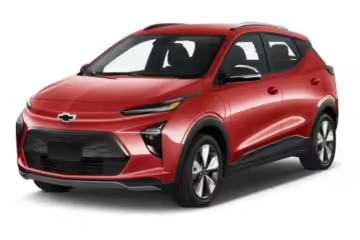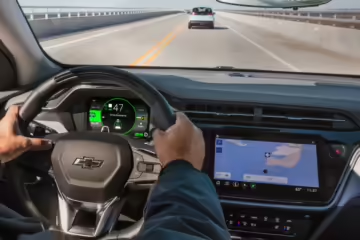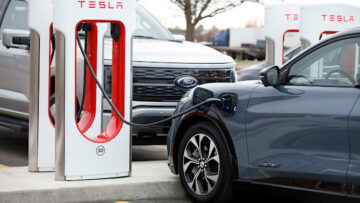by Carol A Westbrook

This autumn we had to buy two cars.
If you are a typical, average, middle-class American, there are times in your life when you have to buy a car. Americans take car ownership—and car buying—very seriously. Since cars and their accessories (insurance, maintainence, repair, e.) occupy such a large part of the family budget, selecting the right one becomes one of the most important decisions that you can make as a family or an individual. And there are many sources of help, from innumerable magazines like Car and Driver, Consumers’ Report, etc., television review shows, friends and relatives. We were fortunate to have a guardian angel in our quest—Chris, a longtime friend who happens to be an automotive engineer who works for General Motors’ building the infotainment systems in their electric vehicles.He was a great source of information for us, and convinced us to look at electric vehicles (EV’s).
We needed two vehicles to keep up with our family and work obligations. Rick needed a new car as the cost of upkeep for his 13-year-old BMW was almost as much as the cost of the car itself. And I was recovering from a motor-vehicle accident which left my 3-year-old SUV so damaged that my insurance company declared it totaled—and provided me with a comfortable settlement that would allow me to purchase a moderately priced car. After much discussion we decided it was time to go electric. We would each purchase electric vehicles (EV’s). And I was insistent that our cars had to have color—no more white, black or gray.
We shopped carefully to get the best deals. Rick found that Hertz was selling off its fleet of Tesla Model 3 EV’s. Although Teslas were considered luxury cars, they were not popular with Hertz customers, most of whom had no experience with EV’s. As for myself, I did not see myself driving the sport-car-like Tesla with its fast acceleration; I preferred a replacement SUV that was sedate, safe and stylish. I scoured used-car sites to find a Chevy Bolt. A red Chevy Bolt. There were government incentives in the form of tax rebates for purchasing a used EV. We also learned that EV’s do not age like Internal Combustion Engine (ICE) autos, because EV’s have so many fewer moving parts than ICE autos. One hundred thousand miles on an EV is not the same as it is on a ICE auto. It is possible to get a good deal on a car with high mileage because the seller does not understand this!
Soon we had two shiny, almost-new, red cars in our driveway. There was my 2022 Chevy Bolt EUV, and Rick’s 2023 Tesla Model 3. At first glance, they look like any other cars. But look carefully—no exhaust pipes!
Next have a look under the hood of the Tesla. It’s empty! Where’s the engine? In a gasoline-powered car you’d find the ICE, but in a Tesla the area under the hood is empty, and is available for luggage storage. It has been renamed the frunk. Other EV’s may have batteries or other parts in this area, but gone are the engine block, the spark plugs, the alternator, fan belts, and other moving parts that need continuous maintenance. Most EV’s, including the Bolt, have powerful electric motors located under the wheels that they turn, and a small 12-volt system for running the accessories such as interior lights, heated seats, infotainment display.
Now get inside the car with the key fob (Bolt) or key-card (Tesla), sit in the driver’s seat, put your foot on the brake and start the engine. The dashboard lights up, but it’s it’s eerily silent, you can’t even tell If the motor is on, as there is virtually no engine noise! Some EV’s, like the Tesla, play a backup noise as a pedestrian warning, but most models of the Bolt do not.

The most noticeable difference in driving an EV vs. an ICE auto is that EV’s have regenerative braking. When the driver takes her foot off the accelerator, the motor can become a generator that charges the batteries. Rather than coasting to a stop, the car slows and stops rather abruptly. Initially this feels weird and may be hard to get used to. Obviously, regenerative braking is something that ICE vehicles cannot do.
Some EVs , including my Bolt and Rick’s Tesla Model 3, have a one-pedal driving mode that allows the driver to accelerate and stop using just the accelerator pedal; I can turn this feature off, in the Bolt, but in the Tesla I cannot. I find that I can drive easily in one-pedal mode but I have to concentrate. It is not automatic, but I’m sure with practice it will become second nature. One-pedal driving is the most energy-efficient way to drive, but it has some limitations, such as not being adequate for panic stops or driving in bad weather. And Tesla is the only automobile that offers a self-driving mode, which has been extensively evaluated for its safety and ability. There is a monthly charge to use this service, which might prove valuable for any number of drivers, such as the elderly who no longer have the ability to drive safely.
One of the most important considerations for potential EV owners is “Range Anxiety”. Range Anxiety is the fear that the car’s charge will run out before they reach their destination or reach another charger. 58% of potential EV buyers in the US have this as a top concern. With good trip planning and a good app to follow, today t his is less likely to happen than it was several years ago.You can easily direct your map program to display the chargers along your route, their brands (e.g. Tesla, Electrify America, etc.) and their distance away. There are panty of chargers in cities and near interstates, fewer in rural areas. Other reasons for not buying an electric car include lack of familiarity, and cost. The federal government has established several levels of tax exemptions for purchasing a new or used EV, up to $7,500 per vehicle, but this only partially makes up the difference. Let us hope that the cost of EV’s will continue to drop making them affordable for everyone.
The number of chargers is rapidly increasing, especially on and around the interstate highways. Tesla has now opened its chargers to all users; the only requirement is an appropriate connector. Most brands of EV chargers have their own connector, and no universal standard has yet been adopted. Charging is very straightforward—park your car close enough to the charger, and plug it in. Your car display (or phone app) will give you the necessary information as to how long it will take to achieve the level of miles that is appropriate for your car. As it happens, 80% of EV charging in the US occurs at home. For example, a commuter may plug his car into a charger for a few hours at work, and then return home at night for a full charge using house current (110V) or an available 220V line, as we added in our garage.

Finally, I wondered if EV’s were truly energy efficient compared to internal combustion engines. A significant advantage of EVs compared to conventional gasoline vehicles is their energy efficiency. EVs use approximately 87%–91% of the energy from the battery and regenerative braking to propel the vehicle. Gasoline vehicles only convert about 16–25% of the energy from gasoline into movement (averaging highway and city driving). Another advantage is that EVs can use any type of fuels, taking advantage of wind and solar, to provide the voltage needed to charge the EV’s battery. The 2022 Bolt has an EPA rating of 115MPGe (miles per gallon equivalent).
I love my new Bolt even more than the BMW X1 that it replaced. It has an extremely comfortable seat, and as smooth, quiet ride. It’s fun to drive, and I feel that it was made for me. If you are considering buying a car now, I strongly suggest going electric. EV’s are better cars, just as cars were an improvement on the horse. You’ll be ahead of the curve, and helping the environment.
